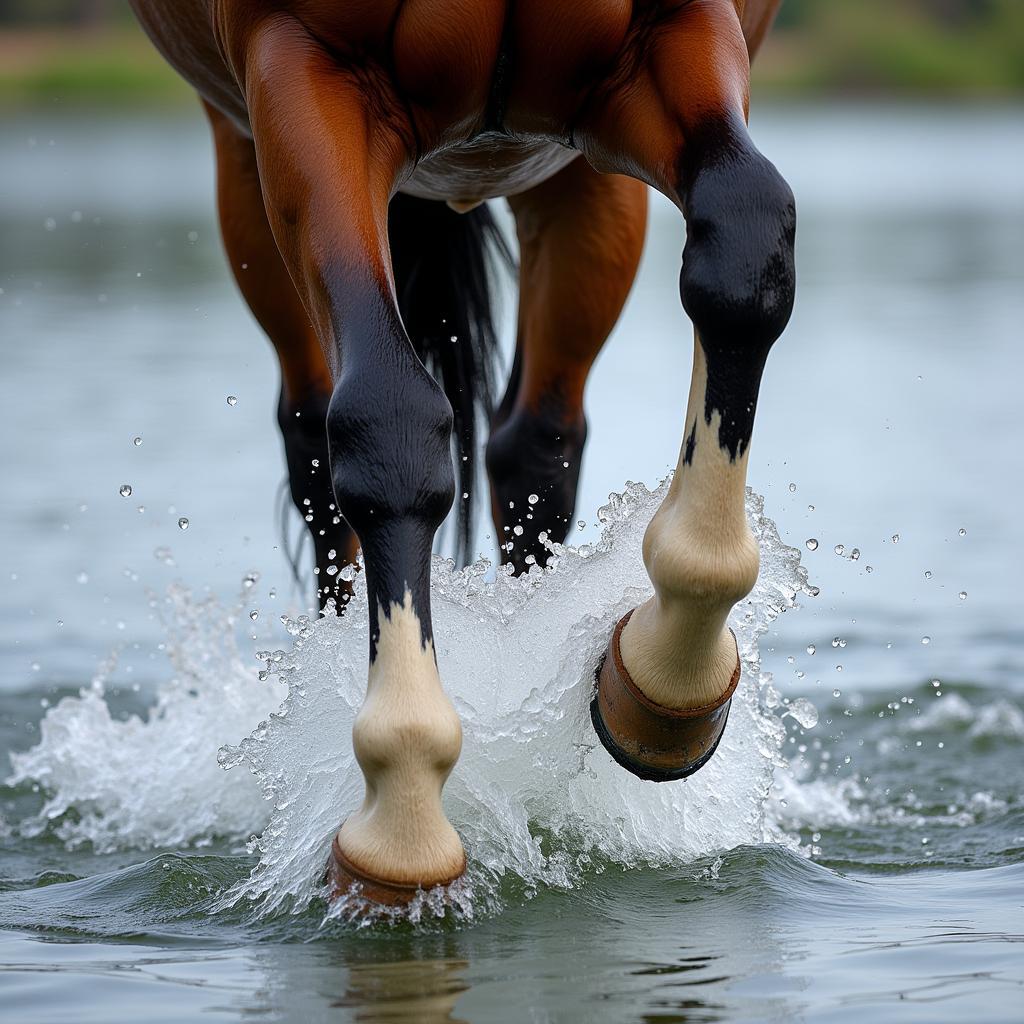The horse paddle, a unique swimming technique observed in horses, is a fascinating subject for equine enthusiasts. This article delves deep into understanding this behavior, exploring its mechanics, evolutionary origins, and implications for horse care and training. We’ll cover everything from the biomechanics of the paddle to its significance in horse behavior and even touch upon some related equine topics. Let’s dive in!  Horse Paddling: A Close-Up View
Horse Paddling: A Close-Up View
Decoding the Mechanics of the Horse Paddle
Horses, unlike many other land mammals, are surprisingly buoyant. This natural buoyancy, combined with a unique limb movement, allows them to perform what we call the “horse paddle.” The action itself is reminiscent of a dog’s paddle, but with key distinctions. The horse uses its front legs primarily, extending them forward and scooping downward in a rhythmic motion to propel itself through the water. The hind legs play a lesser role, providing additional stability and thrust. This paddling motion is less efficient than the swimming style of aquatic mammals but is sufficient for traversing shallow bodies of water. Understanding this mechanics is crucial for appreciating the horse’s natural ability and potential in aquatic environments.
Many people wonder if horses instinctively know how to swim. While the paddle is a natural instinct, experience and confidence in the water play a vital role in a horse’s swimming ability. Horses can be introduced to water gradually, building their confidence and improving their technique over time.
Evolutionary Perspective of the Horse Paddle
Why do horses paddle? The evolutionary reasons for the horse paddle aren’t entirely clear, but several theories offer plausible explanations. One theory suggests it may be a vestigial behavior from earlier equine ancestors that inhabited more aquatic environments. Another theory proposes the paddle developed as a means of traversing flooded plains or escaping predators. Whatever the reason, the horse paddle remains a testament to the adaptability and resilience of these magnificent animals.
Thinking about taking your horse to the beach? Consider checking out our article on White Horse Key Florida for some inspiration. You might even find a need for some new tack after a salty swim – browse our horse tack auction for some great deals.
Horse Paddle: Training and Safety Considerations
Introducing a horse to water should be a slow and gradual process. Never force a horse into deep water. Start by allowing the horse to explore shallow water at its own pace. Positive reinforcement, such as gentle encouragement and rewards, can help build the horse’s confidence. Experienced trainers can provide valuable guidance and ensure the safety of both horse and handler.
Safety Tips for Swimming with Horses
- Always use a properly fitted halter and lead rope.
- Never swim with a horse in fast-flowing water.
- Be aware of potential hazards in the water, such as rocks or submerged debris.
- Check the water depth before entering.
- Supervise horses closely when they are near water.
What if your horse refuses to enter water? This isn’t uncommon. Some horses are naturally more cautious than others. Patience and positive reinforcement are key to overcoming this hesitation. You could even try leading another, more confident horse into the water first to encourage the hesitant horse to follow.
Do you need to transport your horse to a water location? Check out our listings for horse trailer auction. We have a variety of options to suit your needs.
Beyond the Paddle: Other Equine Behaviors
While the horse paddle is a captivating behavior, it’s just one aspect of the rich and complex world of horse behavior. From their social interactions within a herd to their responses to human handling, horses exhibit a wide range of fascinating behaviors that are worthy of further exploration.
Speaking of playfulness, have you considered a horse swing from tire for your equine friend? It’s a great way to provide enrichment and encourage natural behaviors.
You might also find our article about the horse paddle helpful for a more in-depth look at this unique swimming technique.
Conclusion
The horse paddle is a remarkable adaptation that speaks to the versatility of these magnificent animals. By understanding this behavior, we gain a deeper appreciation for their evolutionary history and the intricacies of their physical capabilities. Whether you are a seasoned horse owner or simply fascinated by these creatures, the horse paddle serves as a reminder of the wonders of the natural world.
FAQ
-
Can all horses swim? Most horses have a natural instinct to paddle, but their swimming proficiency varies.
-
How deep can a horse swim? Horses can swim in relatively deep water, but it’s crucial to avoid fast-flowing currents and hidden dangers.
-
How do I teach my horse to swim? Introduce your horse to water gradually, using positive reinforcement and ensuring a safe environment.
-
Is it safe to swim with my horse? Yes, it can be safe, but proper precautions and safety measures are essential.
-
What should I do if my horse is afraid of water? Patience and positive reinforcement are key. Allow your horse to explore shallow water at its own pace.
-
What are the evolutionary reasons for the horse paddle? Theories suggest it may be a vestigial behavior or a means of escape.
-
Are there any specific breeds of horses better at swimming? While some breeds might be slightly more adept, most horses possess the natural ability to paddle.
For further assistance, contact us at Phone Number: 0772127271, Email: [email protected], or visit our address at QGM2+WX2, Vị Trung, Vị Thuỷ, Hậu Giang, Việt Nam. Our customer service team is available 24/7.